The collective Viernes transformed “El 52”, the new emergent space of OMR, in an aviary
The Gallery OMR opened "El 52" a new space next to its habitual place, in which projects of emerging artists are shown. Recently, Remains was inagurated from the Colombian artists Carlos Bonil (in colaboration with La Central, Colombia) and the project Esperanza, from the collective Viernes (Moris and Fernando Carabajal), which it took the space and transformed it the last saturday 24th of July in an aviary of observation and study of fifteen bird couples. The show also consists in a series of 20 drawings placed on the floor of the aviary, and are gradually altered by the bird’s droppings. The Colectivo Viernes works from the parameters set by the characters Robinson Crusoe and Friday (Viernes) in their various literary versions (Defoe, Tournier, Coatzee, etc.), arriving to new places within the habitual apparatus of contemporary art.

Viernes describes the proyec in the following terms:
Speranza is constructed each time depending on the space that is given to us. It is not an in-situ piece but and apparition that generates a new site. Our act of deploying gives a new value to the precepts of the installation, since it does not derive from painting, but from literary references that work into the core of the collective as a possibility of instruction. Contrary to the illustration, Viernes evokes a dislocation of statements; it adds temporary parenthesis to the continuum that exists in the narrative whose instruments –birds in this case- gesticulate and transform in any margin of imprecision and, therefore, exactitude. The drawings are the result derived from the relationship that the birds engage with the habitat set for them, and are, at the same time, the last vestige –the fossil of the footprint on the sand- of the event that was the installation in the future.
In all versions of Robinson Crusoe there is a reflexion about seclution, isolation. If we take this concept into the apparatus of the creative process and the experience of the exposure in an area identified for art, we would find tangential points of contact. That is why we emphasize that our production seeks to create links to establish a humanization system in which the Other –the espectator- is a master piece of our universe. The observer is not and accesory but a character who detonates the scale and, even more importantly, constitutes –like the birds in Speranza- possible points of view to add to our own, because solitude is not an unchanging state but a supportive scaffolding propicious to find new correspondences.
In Daniel Defoe’s version, Robinson works out of the fear that the footprint found in the beach is a sign of, because it symbolizes his own vulnerability; while in the version of Michel Tournier, Robinson works to keep the compendium of knowledge that qualifies him as civilized, also establishing an evolutionary pattern in both figures: while Robinson tends to the metaphysical, Friday tends to the inverse mimesis, where, of all of nature, art emerges. The Colectivo Viernes operates within this sway, in the potential intercrossing inherently quoted by the two heads that comprise it. Without being one or the other character, we assume that each one weaves a role and a series of segments from his solo practice that, in Viernes, is simply implemented. The practice of art in the collective constructs directly from the very desire to materialize what we want to see at all costs, in the communion that a spectator can establish when introduced in the exercise of sensitization and in the act of dismantling, because both temporary polarities (construction and closure) include and foster the work to exist beyond us, unfolding the limits of the piece of art. Each time that Speranza is built, it begins again and in its reactivation it is linked to its former appearance. Each time Speranza is dismantled, a footprint remains, and its closure encourages a new possibility.
Defoe’s Robinson would say: “ The work is itself and act of the spirit and not of the body>>, while Tournier’s Robinson would say: << I work to give myself to the confines of life, to a place suspended between heaven and hell, in one word…Speranza”.”.









